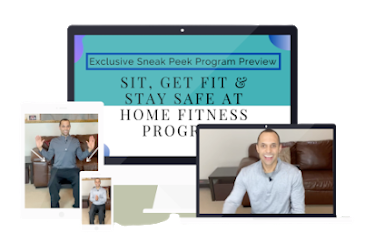Balance Exercises For Seniors Plus 8 Easy Ways To Help You Avoid Another Fall By 33%...
- Preston Brown, DPT, GCS

- Aug 30, 2020
- 4 min read
Updated: Jul 11, 2022

As a leading provider of geriatric physical therapy and fitness services, we primarily work with individuals aged 65+, and most people think falling is a 'normal' part of aging and getting older.
Believe it or not, that’s a MYTH!! Here is an excellent resource from the National Council on Aging titled “Debunking the Myths of Older Adult Falls”.
To reduce future falls, research suggests we must engage in 2 hours of balance and strengthening exercises per week.
Are you or your loved one currently meeting that requirement?
If not, here's a video that includes standing balance exercises for seniors and balance exercises for elderly that can be easily incorporated into your physical activity routine - taking less than 5 minutes!
Balance exercises for older adults that focus on balance and strengthening the muscles in your legs can positively impact your life.
Preventing falls can positively impact your life and by staying out of the hospital, you can remain in your own home and live a happy, healthy life.
Here are 8 easy ways to help lower the risk of a future fall and how to help improve your standing stability, so you can have more confidence getting around the house or while negotiating the community:
1. Stand up as straight as you can
Focus on keeping your posture upright while sitting or standing. As we age, having healthy posture habits can help prevent common neck, shoulder, and back problems and also improve your mood and energy throughout the day.
2. Walk and performing standing activities with your feet slightly apart
Pay special attention to the location of where your feet are in space. Try to keep plenty of distance between your feet to help avoid tripping and help to provide a solid base of support.
3. Shift your weight toward the force
Try to keep the widen distance between your feet and lean towards the force being applied. For example, if you are outside walking in a sweeping wind, try to keep your base of support wide and gently try to lean into the force ever so slightly. Working on this weight shifting in your balance exercise routine is important because too much leaning can 'throw you off balance'.
4. Wear proper fitting, non-slip footwear
Footwear can play an important role in contributing to falls. Wearing proper fitting, non-slip shoes at all times when walking and performing standing tasks around the house can help prevent falls. This will provide improved standing support and help with walking. In particular, research recommends that seniors should wear shoes with low heels and firm slip-resistant soles both inside and outside the home to lower the risk of falls.
5. Work on building leg strength and flexibility
Seniors can experience loss in muscle and joint flexibility. Working on muscle and joint flexibility is something you should try to incorporate daily. Work on building strength and endurance to help with maintaining what muscle strength you have.
6. Focus your gaze on something that's not moving
Find a stationary object and focus on watching that reference point to help with improving your standing balance. Also, having your eyes checked annually should be a priority. Vision plays a primary role in balance and can contribute heavily to falls risk in the elderly.
7. Fall proofing your home and living environment

When we consider falls, about 60% of falls happen at home. We tend to spend the majority of our time in our home environment, and since it is familiar to us, we usually do not consider it hazardous. Meaning, we tend to let down our 'safety guard' and may not take into consideration our safety. Everyone has a different living environment, so to better serve your particular situation consider having a physical therapist assess your home to ensure it is set up correctly for your daily mobility needs. Here is how to 'fall proof' the 5 key areas in your home and living enviornment.
8. Physical therapy and fitness for seniors
Physical therapy has been shown to be an effective treatment in addressing the fear of falling and balance problems for seniors. Incorporating balance activities for elderly along with strengthening exercises for seniors to help improve an older adults' abilities to perform activities throughout the day and also help encourage a safe environment to thrive in. If you or your loved one is suffering from a fear of falling, it is highly recommended that you consult a medical professional to discuss this fear avoidance behavior and this individual would benefit from a fall risk assessment to help lower the risk of future falls.
The balance exercises for seniors, shown above, are a part of Sit, Get Fit & Stay Safe At Home 6-Week Fitness Program. Sit, Get Fit and Stay Safe At Home is an online community not only addressing exercises for seniors but it’s a group of older adults, aged 65+ working together through a fitness program along with myself, allowing for social interactions to help keep you going with some fun, simple exercises that can be done from the comfort of your home.
If you or your loved one lives in the Greater Milwaukee area and would like to learn more about how physical therapy or a trained physical therapist can help you please reach out to us CLICK HERE.
Talk more soon!!
Preston, PT
P.S. if you have not already taken advantage of our FREE Sit, Get Fit & Stay Safe At Home preview —> Click Here


!["[How To Prevent A Future Fall] Top 5 Medications That Matter And How To Incorporate Exercise..."](https://static.wixstatic.com/media/2c667c_a104d3b68c78465f8b41c491109aed4e~mv2.jpg/v1/fill/w_980,h_980,al_c,q_85,usm_0.66_1.00_0.01,enc_avif,quality_auto/2c667c_a104d3b68c78465f8b41c491109aed4e~mv2.jpg)
![[Case Study] "Did Something So Silly Or Stupid Ever Cause A Fall?" ... If YES, You Are Not Alone!](https://static.wixstatic.com/media/2c667c_065c84ac4ffd499dada3d240d61e89ff~mv2.jpg/v1/fill/w_980,h_980,al_c,q_85,usm_0.66_1.00_0.01,enc_avif,quality_auto/2c667c_065c84ac4ffd499dada3d240d61e89ff~mv2.jpg)

Comments